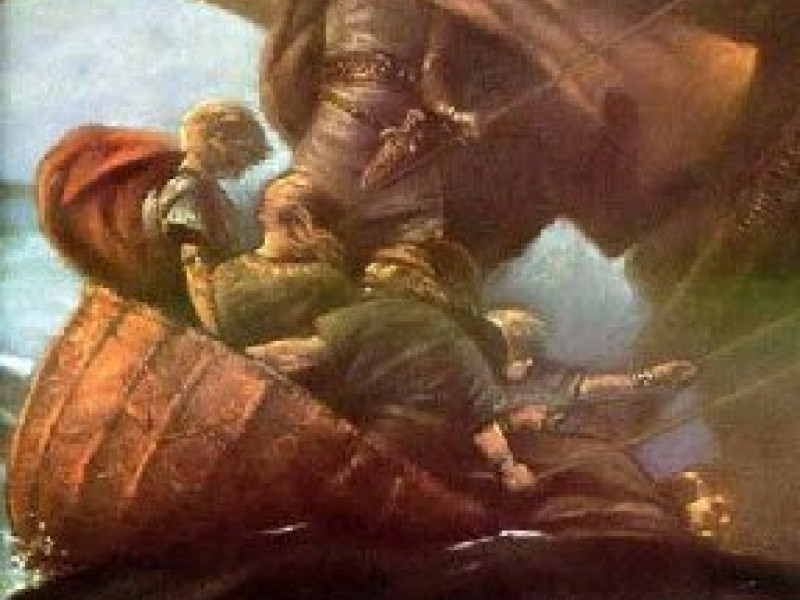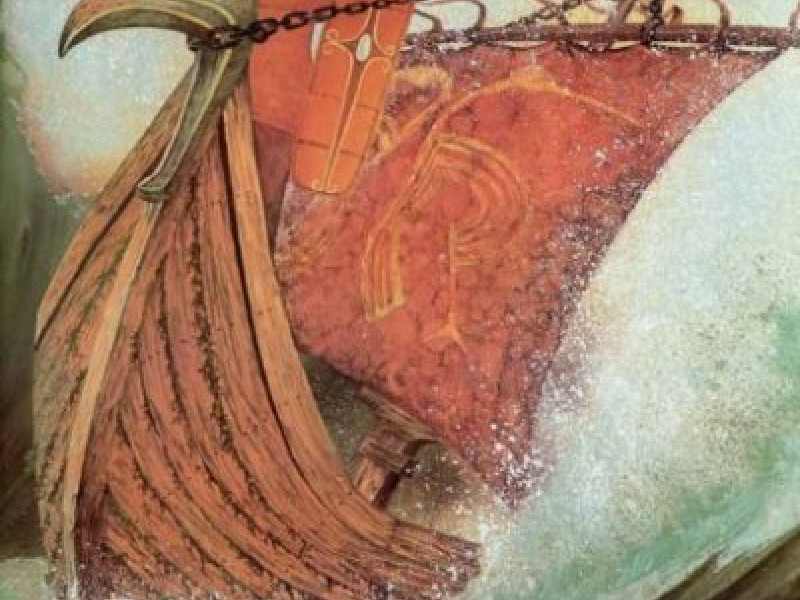Voyage of Bran
The Voyage of Bran (Imram Brain) was one of the oldest tales in Irish literature. It was said that the narrative was first compiled in the 7th century. However, the present work has been preserved in two extant works: the Book of the Dun Cow (early 11th century) and the Book of Leinster (mid-12th century).
The tale is a narrative of a journey made by Bran and his followers to the Isle of Women (known in Irish as "Emne" or "Emain Ablach"), and his attempt to return home.
Invitation to the Otherworld
Bran, the son of Febal, was strolling outside of his stronghold or dun, when he heard music behind him. No matter how he turned his head, the music was always behind his head. The music was so sweet that it lulled him into a magic slumber.
When Bran woke from his strange sleep, he saw a silver branch with white apple blossoms. Bran brought the branch with him to show his family and friends where he had met a woman in a strange gown. The woman sang of the Emain Ablach (Emne or "Isle of Women"), where beautiful women lived.
The season never changed, the weather was perfectly sunny, and yet there was always water. There was always an endless supply of food. The people never became sick or grew old. You could also never die, nor know grief and sorrow. She was describing the Otherworld.
The woman ended her song with an invitation for Bran to seek out her beautiful island before she left, taking the silver branch and blossoms with her.
The next day, Bran organised three companies of nine men in three currach (plural for curragh or boats), which included his three foster-brothers, as they embarked on a voyage to visit the Isle of Women.
They would sail on for two days before meeting a man standing on a chariot drawn by a golden horse, as if he were driving in an open plain, instead of "driving" on the sea.
The charioteer introduced himself as Manannán Mac Lir, the Irish god of the sea. Manannán told them that he would become the father of Mongan, by sleeping with Caintigern, the wife of Fiachna.
Manannán also sang about Emain Ablach.
Manannán also encouraged Bran to seek out the island. Manannán told Bran that he should reach it before sunset.
Related Information
Name
Bran – "Raven".
Sources
Imram Brain (The Voyage of Bran) from the Book of the Dun Cow and the Book of Leinster.
Contents
Invitation to the Otherworld
Isle of Women
Related Articles
Isle of Women
Before he reached the Emain Ablach (the Isle of Women), the voyagers reached an island where they found a crowd of people laughing in delight. Bran sent one of his followers to explore the island.
As Bran's companion came upon the people, he began to laugh like the islanders. When Bran saw that his missing companion would not return, he didn't send anyone else to fetch him. So they left their companion behind on the Isle of Joy or Isle of Merriment, and sailed away.
Not long after leaving the Isle of Joy, they arrived at their destination. They found a woman waiting for them on the shore.
Apparently, Bran had some misgivings about landing at the port of the Emain Ablach. The leader of the women produced a magic ball of thread in her hand. Holding on to one end of the thread, the queen threw the ball to Bran's curragh. When Bran caught the ball of thread, he could not let go of the ball. The queen easily pulled the curragh to her island.
(This magic ball of thread was the property of the queen in tale called the Voyage of Mael Duin. It is quite possible that this was the same island that Mael Duin visited (including the Isle of Joy), as well as the same queen.)
The queen and the other women welcomed the visitors quite warmly. Each man was paired off with a woman of the island. Bran shared his bed with the queen.
As they had been told, they lived on the island where there was no change to the sunny weather. The food and wine were never in short supply. All of their desires were sated.
It seemed that they had only stayed on the beautiful island for a few years. Bran and his companions didn't realise how much real time had passed in the outside world.
One day, Nechtan the son of Collbran felt homesick, and informed Bran that he wished to return home to Erin (Ireland). Bran told the queen that they would now return home. The Queen warned them that they would regret it if they left the island.
However, Bran insisted on leaving the Isle of Women. So the Queen warned them that should not set their feet on dry land, if they returned to Ireland. (This is so unlike the tale of Mael Duin, where the queen kept them on the island against their will. See the Queen and her Magic Clew in the Voyage of Mael Duin, for comparison.)
Bran and his companions departed from the isle, and picked up their missing companion on the Isle of Joy. They arrived at Srub Brain (somewhere in Ireland), while staying on their currach. One of the men on the shore, who saw the arrival of the currach, asked them who they were. Bran replied that he was Bran, the son of Febal. The man on the shore replied that they knew of no one named Bran, except what they had been told in their ancient legends.
Nechtan, ignoring the queen's warning to not set foot on dry land, leaped out of the curragh. The moment he touched dry land, Nechtan was reduced to ashes, as if he had been part of the earth for hundreds of years.
Bran told the people on the shore of his adventures on the Isle of Women, and thus their story was recorded. Then Bran and his companions sailed away in their currach, and were never heard from again.
Related Information
Contents
Invitation to the Otherworld
Isle of Women
Related Articles
By Jimmy Joe



